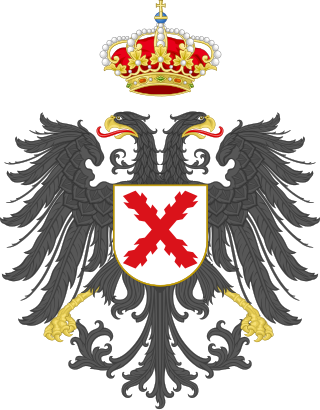
Tomás de Zumalacárregui e Imaz, known among his troops as "Uncle Tomás", was a Spanish Basque officer who led the Carlist faction as Captain general of the Army during the First Carlist War. He was occasionally nicknamed the "Wolf of the Amezcoas", making reference to his famous military victory in the region of Navarre.

Carlism is a Traditionalist and Legitimist political movement in Spain aimed at establishing an alternative branch of the Bourbon dynasty, one descended from Don Carlos, Count of Molina (1788–1855), on the Spanish throne.

Baldomero Fernández-Espartero y Álvarez de Toro was a Spanish marshal and statesman. He served as the Regent of the Realm, three times as Prime Minister and briefly as President of the Congress of Deputies. Throughout his life, he was endowed with a long list of titles such as Prince of Vergara, Duke of la Victoria, Count of Luchana, Viscount of Banderas and was also styled as "the Peacemaker".

The First Carlist War was a civil war in Spain from 1833 to 1840, the first of three Carlist Wars. It was fought between two factions over the succession to the throne and the nature of the Spanish monarchy: the conservative and devolutionist supporters of the late king's brother, Carlos de Borbón, became known as Carlists (carlistas), while the progressive and centralist supporters of the regent, Maria Christina, acting for Isabella II of Spain, were called Liberals (liberales), cristinos or isabelinos. Aside from being a war of succession about the question who the rightful successor to King Ferdinand VII of Spain was, the Carlists' goal was the return to a traditional monarchy, while the Liberals sought to defend the constitutional monarchy.

The War of the Pyrenees, also known as War of Roussillon or War of the Convention, was the Pyrenean front of the First Coalition's war against the First French Republic. It pitted Revolutionary France against the kingdoms of Spain and Portugal from March 1793 to July 1795 during the French Revolutionary Wars.

The Restoration or Bourbon Restoration was the period in Spanish history between the First Spanish Republic and the Second Spanish Republic from 1874 to 1931. It began on 29 December 1874, after a coup d'état by General Arsenio Martínez Campos ended the First Spanish Republic and restored the monarchy under Alfonso XII, and ended on 14 April 1931 with the proclamation of the Second Spanish Republic.

General Sir George de Lacy Evans was an Irish officer in the British Army who served in four of the United Kingdom's 19th century wars. He became a long-serving Member of Parliament.

March of Oriamendi, is the anthem of the Carlist movement. The name of the anthem stems from the battle of Oriamendi which took place in 1837 during the First Carlist War.

The Third Carlist War, which occurred from 1872 to 1876, was the last Carlist War in Spain. It is sometimes referred to as the "Second Carlist War", as the earlier "Second" War (1847–1849) was smaller in scale and relatively trivial in political consequence.

DomSebastian Gabriel de Borbón y Braganza, Infante of Portugal and Spain, was an Iberian prince of the 19th century, progenitor of the Spanish ducal lines of Hernani, Ansola, Dúrcal and Marchena, and Carlist army commander in the First Carlist War.

The Battle of Santander was fought in the War in the North campaign of the Spanish Civil War during the summer of 1937. Santander's fall on 26 August assured the Nationalist conquest of the province of Santander, now Cantabria. The battle devastated the Republic's "Army of the North"; 60,000 soldiers were captured by the Nationalists.

The British Auxiliary Legion, also called the British Legion or Westminster Legion, existed from 1835 to 1837. It was a British military force sent to Spain to support the Liberals and Queen Isabella II of Spain against the Carlists in the First Carlist War.

The Battle of Irún was the critical battle of the Campaign of Gipuzkoa prior to the War in the North, during the Spanish Civil War. The Nationalist Army, under Alfonso Beorlegui, captured the city of Irún cutting off the northern provinces of Gipuzkoa, Biscay, Santander, and Asturias from their source of arms and support in France.
Oliver De Lancey (1803–1837) was a British Army officer who volunteered for the British Auxiliary Legion and died fighting in Spain during the First Carlist War, in the battle of Oriamendi.
Pedro Sarsfield y Waters was a Spanish general of Irish descent who commanded an infantry division during the Peninsular War. He is considered one of the best Spanish tacticians among his generation.

Baron Wilhelm von Rahden was a German officer and writer.
José Juan Santesteban was a Basque composer, father of José Antonio Santesteban. In 1844 — 1879 he was organist in Santa Maria, Donostia.

The Battle of Andoain was a military engagement of the First Carlist War that was fought on 14 September 1837. It took place around the Basque village of Andoain, south of the main Liberal stronghold of San Sebastián. Liberal troops under Leopoldo O'Donnell had captured Andoain on 9 September, driving the Carlist garrison there to the western bank of the Oria. Over the next three days, both sides constructed breastworks amidst intermittent skirmishes. After two days of trench warfare, Carlist troops poured heavy artillery fire on the Liberal lines and launched an all-out offensive, supported by reinforcements brought in from Navarre by José Ignacio de Uranga.
The Foreign Legion was established in 1831 by King Louis Philippe I to consolidate all foreign corps fighting under French colors, which included, among others, the Swiss Guards, the Swiss regiment of the Royal Guard, and the Hohenlohe Regiment. After its creation, the Legion participated in the further recruitment of foreign nationals into French military service.

Lieutenant-Colonel Sir Duncan MacDougall was a British Army officer who fought in the Peninsular War and War of 1812. He rose to command the 79th Regiment of Foot before serving as second-in-command of the British Auxiliary Legion during the First Carlist War.

















